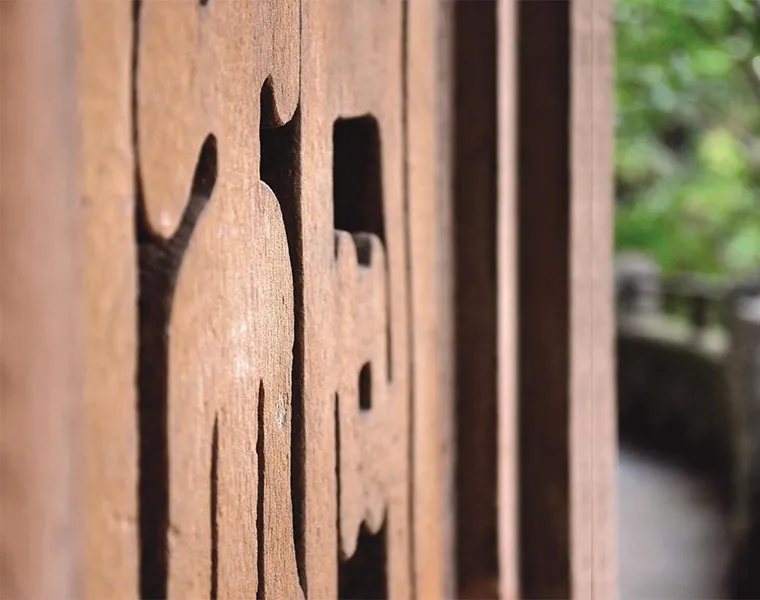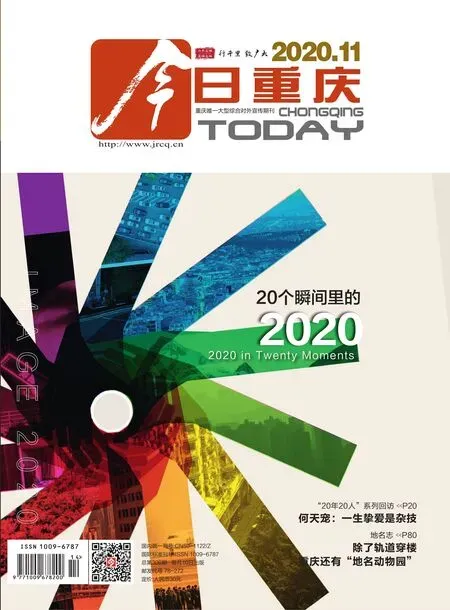侯宝川:守望大凉山
◇| 文本刊记者 陈科 龙实习 生朱江 怡| 图 刘一 周 受访者提供
侯宝川:守望大凉山
Hou Baochuan: Looking out Daliang Mountains
走进位于虎溪公社的侯宝川画室,仿佛置身于一片芳香馥郁的田间地头。画室四壁,挂满了一幅幅意境悠远的田园风景画,田野、溪水、池塘、远山、白杨、梯田、冬雪……对于久居城市的人来说,这一切都让人心驰神往。
Walking into Hou Baochuan studio in Huxi Art Commune is like walking into fields full of fragrance. There are many pastoral landscape paintings hanging on the wall. Fields, streams, ponds, mountains, white poplars, terrace, and snow, all make residents in cities long for them.
一句话锁定一生
One Piece of Suggestion
不到1岁,侯宝川就随父母去到了大凉山生活。父亲在凉山州文化馆任馆长,侯宝川从小就认识很多艺术家,自然而然喜欢上了画画。“小时候就是画着玩,真正开始学习画画是在1974年。”侯宝川回忆起43年前的那段往事。
16岁那年,侯宝川和亲朋好友到成都看画展,在艺术馆恰巧见到了正在创作的钱来忠老师(钱来忠曾任四川省艺术馆馆长、四川省文化厅副厅长、四川省美术家协会主席)。一番交谈后,钱来忠建议侯宝川把画画作为一技之长,可以在那个特定的年代当作踏入社会的“敲门砖”。当时,钱来忠还给侯宝川画了一幅头像,送给了他一把炭笔,嘱咐他要勤加练习。
“钱老师那么一说,基本上就锁定了我的一生,势必要与画画相伴。”从那之后,侯宝川就开始临摹练习、访师问道,一刻也不敢停歇。
恢复高考后的第一年,在荣昌下乡当知青的侯宝川就报考了川美,只是结果不尽如人意。

布面油画《回乡路》130x162cm 2017年
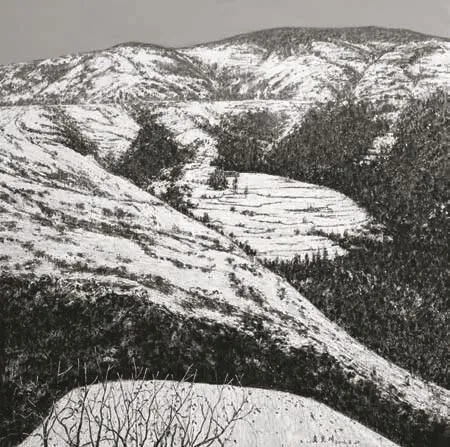
布面油画《融雪系列2016NO5》200x200cm 2016年

布面油画《急转弯No6》180x160cm 2013年
“那时的高考,千军万马过独木桥,几千名考生,只招几十人。许多考生都在城里受过专业训练,我是自学,第一年没考上。”对艺术的爱透进了骨子里,侯宝川没有灰心,他一年接一年地考,第五年终于考上了川美。
Less than 1 year old, Hou Baochuan went to Daliang Mountains with his parents. His father worked as curator of Liang Shan Zhou cultural centre, so he had known many artists since childhood and naturally liked to paint. It was in 1974 that Hou Baochuan started to learn painting systematically.
At the age of 16, Hou Baochuan visited an art exhibition in Chengdu with his relatives and friends where he met Qian Laizhong, then curator of Art Gallery of Sichuan Province, who was painting. After talking to him, Qian Laizhong suggested he should learn painting as an important skill to live at that age. Qian Laizhong also drew a portrait for him and gave him a charcoal pencil to encourage him.
From then on, Hou Baochuan began to practice copying, visit artists,lean from them and wouldn’t stop for a second.
At the first year after the college entrance exam mechanism was reinstated, Hou Baochuan who was teaching in Rongchang Workers’ Children School took the entrance examination of Sichuan Fine Arts Institute but failed.
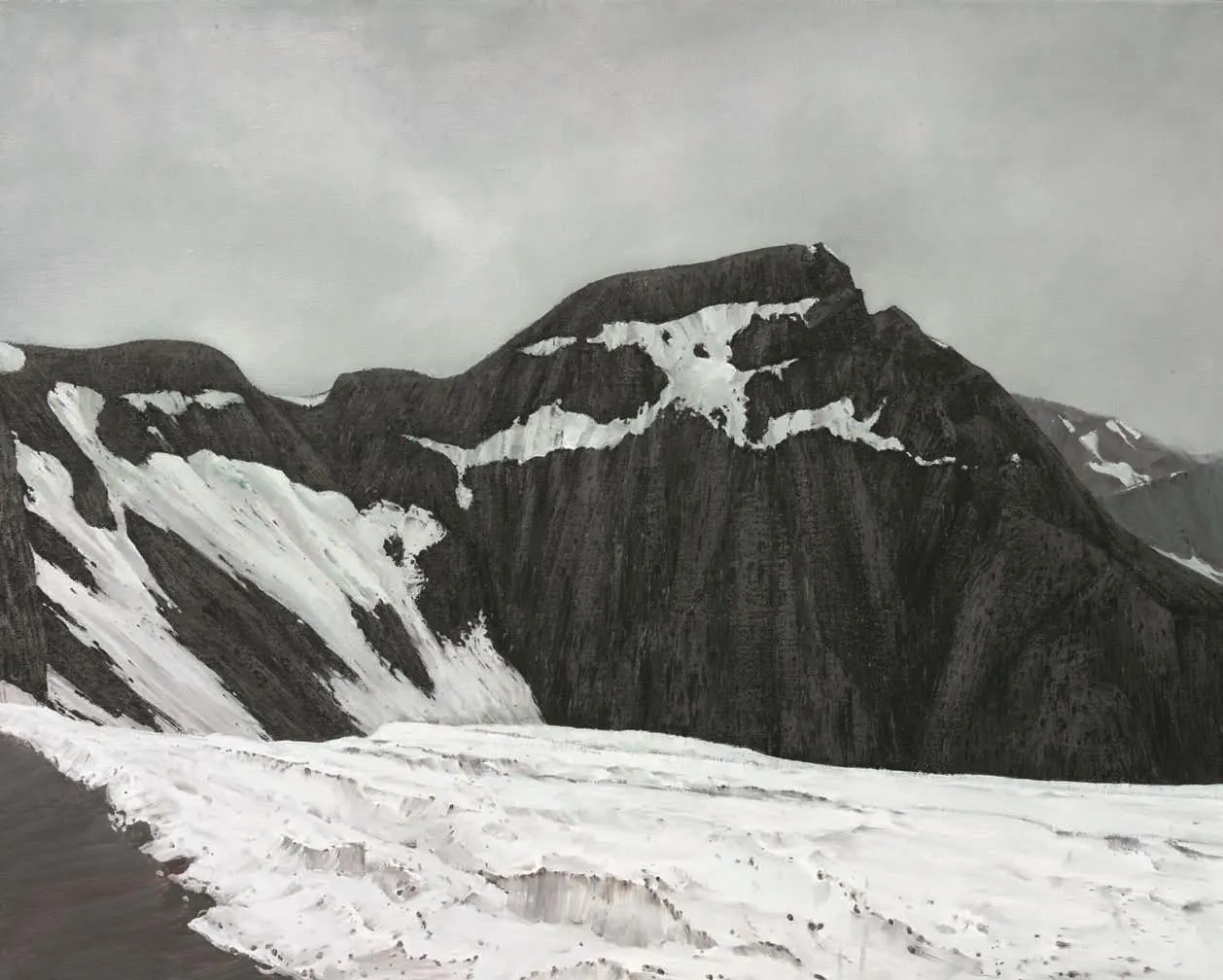
布面油画《黑山白雪》100cmx80cm 2014年
“Taking the college entrance exam at that time was like thousands of horses and soldiers passing through a single-log bridge. Many candidates had been trained in the city but I learned painting by myself, so I didn’t pass the exam.” Hou Baochuan said. He was finally admitted by Sichuan Fine Arts Institute at the fifth year.
画笔回归大凉山
Brushes Back to Daliang Mountains
侯宝川是班里年长的学生。“我的老师张晓刚和叶永青和我是同年出生的,我们既是师生,也是兄弟伙。”上世纪八十年代,西方当代艺术传入中国,张晓刚和叶永青把西方当代艺术的理念、表现手法等引入课堂,直接影响了侯宝川早期的风景画创作。
侯宝川的风景画创作,最早是在平面装饰画上取得的突破。装饰画讲究规范,注重唯美的视觉效果,侯宝川的平面装饰画创作越来越得心应手,有一次他的一幅作品竟然被老师的夫人误认为是老师的作品。侯宝川意识到自己的风格和老师走得太近,反而难以凸显自己的特色。于是,他开始寻求转变。
俗话说,一方山水养一方人,侯宝川想到了自己生长的土地——大凉山。
“如果不画自己最熟悉最了解的东西,不去追思乡愁乡情,作品出来以后就会显得很苍白。”经历了这样一番思考,上世纪九十年代中期,侯宝川将画笔伸向了他熟知的土地。
“想到大凉山就会想到母亲。我出生后,她一直留在大凉山,去世后也长眠在大凉山。每年,我都要回大凉山好几次,去看那个地方,其实就是看我的母亲。大凉山也就成了我永恒的创作主题。”侯宝川一边说着,一边扶了扶眼镜,不觉想起母亲已经离开50个年头了。
Hou Baochuan was older in the class. “My teachers, Zhang Xiaogang and Ye Yongqing and I were born in the same year, so we can be both teachers and students, and brothers.” Western contemporary art was introduced into China in the 1980s and Zhang Xiaogang, and Ye Yongqing introduced the idea of western contemporary art and techniques of expression into class, which directly affected Hou Baochuan’s early landscape paintings.
Like old saying goes, each place has its streams in from all over the country. Hou thought about the place where he grows up, Daliang Mountains.
If an artist don’t draw what he is most familiar with and don’t go after homesickness, his worksare skin-deep. After such consideration, Hou reached the land he knows through brushes in the mid-1990s.
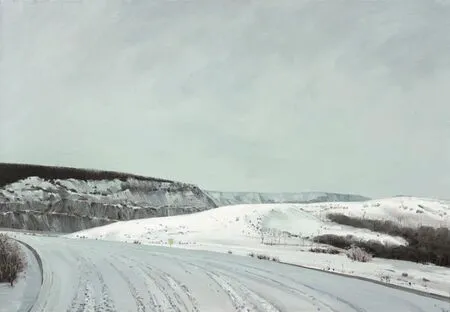
布面油画《融冬·路NO3》100cmx80cm 2013年
“When I think of Daliang Mountains, I will think of my mother. She had been living in Daliang Mountains since I was born and she rests there forever after she died. Every year, I would go back to commemorate her. Daliang Mountains has become my eternal painting theme.” Hou Baochuan said, while adjusted his glasses, and his mother had left him for 40 years.
走上一条回归的路
Deep Love and Praise for Daliang Mountains
在“大凉山”系列作品中,侯宝川大多采用直线化的分割,笔触粗犷有力,那些斑驳的肌理丰富了画面的情绪。
为了追求博大、恢宏的气势,侯宝川用全景式的构图,弱化对远山与天空的描绘,反而让其与中景内的大地融汇在一起,从而产生一种混沌、苍茫的意象。
“这些年,大凉山的风景成为我笔下表现的主题,因此产生了‘布拖坝子’系列。彝族同胞世世代代生活在大凉山,蛮荒的大山和恶劣的气候,造就了他们粗犷的性格和强烈的生存愿望。彝族人的吃苦精神是常人无法理解的,他们的韧性也是常人无法想象的。在艰苦的自然环境中,他们顽强地与天斗、与地斗,在贫瘠的土地上辛勤的劳作,创造着丰收和富裕的奇迹。”侯宝川这样阐释这一阶段的创作。
当前关于《史记》英译研究成果斐然,但是研究成果主要集中在翻译学方面,鲜有从传统文献语言学的角度去研究。有中文系学者曾作为倪译“翻译坊”成员之一,参与了倪译某初稿的讨论,认为“严谨地英译《史记》原文,或许会促进《史记》文本本身的进一步研究”(曲景毅2014)。倪豪士在谈及他翻译中遇到的困难时说:“真正了解《史记》的中国人,没有什么英文的能力……问他们英文的一句话,他们都不懂。如果年轻人学了古典文学,也学了英文,那是最好的”(2015年8月22日凤凰江苏网采访)。可见,多视角、多维度、跨学科研究一定会促进翻译本身和对原作的研究。
在侯宝川画笔下,大凉山是具有象征意义的风景,在苍凉、苦涩、凝重的画面背后,是他对大凉山的热爱,以及对生活在这片土地上的人们的礼赞。
翻看侯宝川的作品集《诗意的栖居》,会发现许多以大凉山为主题的风景画,都有一条路,或者田间小路,或者山间“天路”,或者高速公路。
“那是一条回归的路。”侯宝川说自己上了年纪了,常常想回到大凉山,哪怕是坐在农家院坝里喝碗水都能心满意足。
乡愁之情和民族认同,让侯宝川在大凉山找到了自己的根,反哺他的油画作品以浓浓的人文气息。
侯宝川指着四幅有道路的作品说:“这是路之春夏秋冬,从早年险峻的‘天路’油画,到如今四通八达的高速路油画,那不仅仅是我回归故土的路,更是当地彝族同胞致富的路。”
In the “Daliang Mountains” series, Hou Baochuan uses straight lines to split the image and mottled texture to enrich the mood of the picture.
In pursuit of broad, magnificent momentum, Hou Baochuan composes with panoramic view, weakening the depiction of distant mountains and the sky and making them integrated with land, to produce a chaotic and vast image.
“Over the years, the landscape of Daliang Mountains was my composition theme, so the‘Bu Tuo Ba Zi’ series was produced. People of Yi nationality live in Daliang Mountains from generation to generation and wild mountains and harsh climate contributed to their rough character and strong desire to survive. They doggedly fight the terrible natural environment and barren earth to create the miracle of harvest and richness.” Hou Baochuan explained his composition at this stage of creation.
Under the brush of Hou, Daliang Mountains are symbolic. Behind the desolate and dignified image were Hou’s love of Daliang Mountains and praise for the people who live there.
Looking through Hou Baochuan’s collection“Poetic Habitation”, one will find roads, paths or highways would appear in landscape paintings with Daliang Mountains as the theme.
They are ways of going back. Hou Baochuan said he is getting old and often thought about returning to Daliang Mountains. Even drinking water sitting in a farmer’s house contents him.
Homesickness and national identity make Hou Baochuan find his root which were expressed in his oil paintings.
Pointing at four paintings with roads, Hou said they are roads in spring, summer, autumn and winter. From steep mountain roads to highways, they are not only his ways of going back home, but also ways of people of Yi nationality getting well-off.

布面油画《秋野》116cmx80cm 2014年
进入对自然的静观与哲思
Into Contemplation of Nature and Philosophizing
2012年以来,侯宝川的作品中,出现了大量的大凉山雪景,如2014年的作品《黑山白雪》《长云静山》。
“这些雪景作品,表明了画家内心世界的提炼与升华。”中央美术学院教授、博士生导师殷双喜已经留意到,侯宝川的绘画试图超越现实世界的视觉盛宴,进入一种对自然的静观与哲思,“这是十分难得的风景境界。”殷双喜指出,侯宝川的风景绘画,接近中国古代画家的自然观与人生观,可以看出古代文人与自然的心理联系。
事实上,侯宝川寄情于自然山水,却没有传统文人容易患上的消极避世。他的风景画,画的是人们劳作和生活的家园,是春播秋收的土地,是皑皑白雪下垄埂纵横的庄稼地,弥漫着强烈的生活气息,有着可感的温度。
侯宝川几乎把风景画当作了自己惟一的创作方向,从上世纪九十年代开始,几十年来,他心无旁骛始终醉心于描绘山岗河流、丘壑丛林和四时景色。表面上他画的是自然风景,本质上却是人文的景象。
中国艺术研究院美术研究所研究员王端廷看过侯宝川的油画作品后曾说,“侯宝川的风景画把当代都市人对自然的向往和迷恋之情表现得淋漓尽致,他为自己也为我们建造了一个寄托心灵的诗意家园。”或许,这是对侯宝川和他的风景画的另一种“素描”。
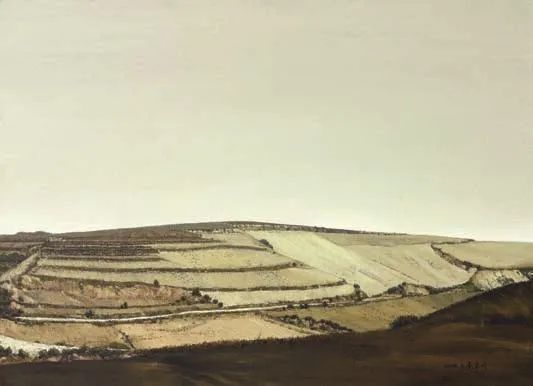
From 2012, there are many Daliang Mountains snowscape appearing in the works of Hou, for example, “Black Mountain and White Snow” and“Quiet Mountain under Clouds”.
“The snowscape paintings present the refining and sublimation of the painters’ inner world.”Yin Shuangxi, professor and doctoral supervisor of Central Academy of Fine Art has noticed that Hou’s paintings attempt to go beyond real world visual feast and into contemplation of nature and philosophizing. “It was a rare scenery state.” Yin Shuangxi said, also he pointed out that from Hou’s paintings, people can see the psychological contact between ancient literati and nature.
Hou Baochuan expressed himself by natural landscape but he didn’t have a negative attitude like traditional literati. His landscape paintings were homeland where people farming and living in, earth on which people harvest and fields under snow, which were full of life.
Hou Baochuan almost uses landscape painting as his unique composition direction. Starting in the 1990s, he was indulged in portraying hills, rivers, jungles and views in different seasons for decades. Seemingly, he was painting natural landscape, but in nature humanistic picture.
After seeing Hou’s paintings, Wang Duanting, an researcher in Art Institute of the Chinese National Academy of Arts, said: “Hou Baochuan’s paintings portray contemporary urbanite’s longing and fascination for nature incisively and vividly. He built a poetic homeland for himself and for us.” Perhaps, this is another “sketch”for Hou Baochuan and his landscape paintings.
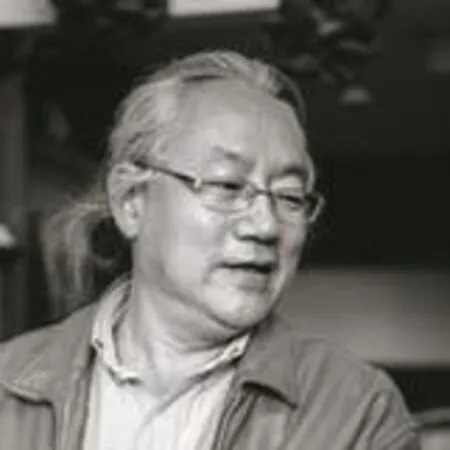
侯宝川
Hou Baochuan
1958年10月生于四川成都,1986年毕业于四川美术学院美术教育系并留校工作。现任四川美术学院副院长、教授、硕士研究生导师,中国美术家协会会员、重庆美术家协会副主席。
Hou Baochuan was born in Chengdu, Sichuan Province in 1958 and graduated from Sichuan Fine Arts Institute in 1986 and worked there. As associate dean, professor and master supervisor of Sichuan Fine Arts Institute, he is also vice president of Chongqing Artists Association, and a member of China Artists Association.
